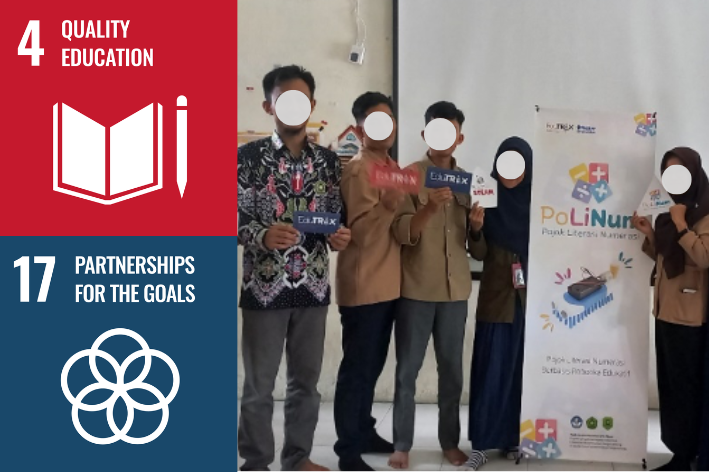Main Article Content
Abstract
Mathematical literacy skills are crucial for solving everyday mathematical problems. However, at SD Muhammadiyah Pangkal Pinang, students' numeracy literacy skills are still relatively low. This condition is exacerbated by the absence of a dedicated numeracy literacy learning center and the limited skills of teachers in designing and developing such resources. This community service (PkM) activity aimed to introduce a numeracy literacy corner to teachers as an initial step towards establishing a more comprehensive learning center. The implementation method for this PkM included three stages of socialization: pre-activity, concept introduction, and evaluation. The results showed that teachers gave positive feedback on the numeracy literacy corner, considering it more engaging than conventional reading corners. It is hoped that this initiative can serve as a foundation for the optimal realization of a numeracy literacy learning center in the classroom in the future.
Keywords
Article Details

This work is licensed under a Creative Commons Attribution-NonCommercial 4.0 International License.
References
- Adelia, V., & Putri, R. I. I. (2024a). A systematic literature review: how do we support students to become numerate? International Journal of Evaluation and Research in Education , 13(3), 1816–1824. https://doi.org/10.11591/ijere.v13i3.26849
- Adelia, V., & Putri, R. I. I. (2024b). Mathematics Teachers in Palembang Teaching Practice: Numeracy Perspective. AIP Conference Proceedings, 3052(1). https://doi.org/10.1063/5.0201098
- Arifudin, R., Sugiharti, E., Abidin, Z., & Setiawan, A. (2024). Penggunaan Media Robot Edukasi dalam Pembelajaran STEM Bagi Guru Sekolah Dasar di Kota Semarang. Jurnal Pengabdian Teknik Dan Sains (JPTS), 4(1), 25–34. https://doi.org/10.30595/jpts.v4i1.19412
- Budiyanto, C. W., Fenyvesi, K., Lathifah, A., & Yuana, R. A. (2022). Computational Thinking Development: Benefiting from Educational Robotics in STEM Teaching. European Journal of Educational Research, 11(4), 1997–2012. https://doi.org/10.12973/eu-jer.11.4.1997
- Eguchi, A. (2015). Educational Robotics as a Learning Tool for Promoting Rich Environments for Active Learning (REALs). In In Handbook of Research on Educational Technology Integration and Active Learning. https://doi.org/10.4018/978-1-4666-8363-1.ch002
- Evans, D. (2017). Examining the literacy within numeracy to provide access to the curriculum for all. International Perspectives on Inclusive Education, 11, 35–51. https://doi.org/10.1108/S1479-363620170000011003
- Ikpeze, O., Ejidokun, T., & Onibonoje, M. (2022). Smartphone Control Mobile Robot for Education and Research. Journal of Robotics, 2022. https://doi.org/10.1155/2022/5178629
- Juuti, K., Lavonen, J., Salonen, V., Salmela-Aro, K., Schneider, B., & Krajcik, J. (2021). A Teacher–Researcher Partnership for Professional Learning: Co-Designing Project-Based Learning Units to Increase Student Engagement in Science Classes. Journal of Science Teacher Education, 32(6), 625–641. https://doi.org/10.1080/1046560X.2021.1872207
- Krishnamurthy, B., Senbagarajan, S., & Mahendran, L. (2023). Design and Fabrication of Spider Bot. AIP Conference Proceedings, 2946(1). https://doi.org/10.1063/5.0178024
- La Paglia, F., La Cascia, C., Francomano, M. M., & La Barbera, D. (2017). Educational robotics to improve mathematical and metacognitive skills. Annual Review of CyberTherapy and Telemedicine, 15, 70–75.
- MIPA.KP. (2023). Hasil Analisis Uji Soal MNR 2023 SD Muhammadiyah Pangkalpinang.
- Nauman, N., Mustafa, H., Ashraf, A., & Khalil, H. (2025). Design and Implementation of an On-Board System for a Spider Robot. In Securing the Digital Realm: Advances in Hardware and Software Security, Communication, and Forensics (pp. 62–69). https://doi.org/10.1201/9781003497851-6
- Notomista, G., Mayya, S., Mazumdar, A., Hutchinson, S., & Egerstedt, M. (2019). A Study of a Class of Vibration-Driven Robots: Modeling, Analysis, Control and Design of the Brushbot. IEEE International Conference on Intelligent Robots and Systems, 5101–5106. https://doi.org/10.1109/IROS40897.2019.8968490
- OECD. (2018). PISA 2018 Assessment and Analytical Framework. OECD.
- Ortiz, I. R. (2023). Robotics in the Area of Mathematics in Primary Education. A Systematic Review. Edutec, 84, 1–17. https://doi.org/10.21556/edutec.2023.84.2889
- Pickering, J., Attridge, N., Inglis, M., & Morsanyi, K. (2025). Numeracy, logical reasoning and real-world decision making. Research in Mathematics Education. https://doi.org/10.1080/14794802.2025.2472675
- Rohati, R., Kusumah, Y. S., & Kusnandi, K. (2023). Exploring Students’ Mathematical Reasoning Behavior in Junior High Schools: A Grounded Theory. Education Sciences, 13(3). https://doi.org/10.3390/educsci13030252
- Siahaan, M. M. L., Tamba, K., Suddin, S., & Bete, H. (2023). Study on preservice mathematics teacher: An analysis of numeracy literacy by open-ended task in geometry. AIP Conference Proceedings, 2595. https://doi.org/10.1063/5.0123817
- Tout, D. (2020). Evolution of adult numeracy from quantitative literacy to numeracy: Lessons learned from international assessments. International Review of Education, 66(2–3), 183–209. https://doi.org/10.1007/s11159-020-09831-4

